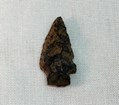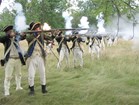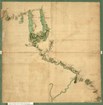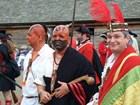Many Native Americans lived and died in the vicinity of the Oneida Carry. Tribes, families, and individuals were often pulled in different directions as the European world invaded theirs. Learn more of this history here.
-
Fort Stanwix National Monument
Article 1: Archaic Brewerton Projectile Point

This Brewerton corner-notched projectile point was recovered during the 2003 archeological excavation that preceded the construction of the Willett Center. Dating to the Archaic period (9,000 – 3,000 BP), the point represents Native Americans’ use of the land around Fort Stanwix prior to contact with Europeans. Read more
-
Fort Stanwix National Monument
Article 2: Archaic Lamoka Projectile Point

Fort Stanwix was built upon a hill that had been visited by American Indians long before the arrival of the Europeans. These prehistoric visitors left behind no written evidence, but only artifacts of their culture beneath the ground. When archaeologists excavated Fort Stanwix in the 1970’s, they discovered these sparse clues in addition to the historic fort. Read more
-
Fort Stanwix National Monument
Article 3: Jesuit Ring

This heart-shaped ring was one of thousands used for trade, gifts, and religious purposes as French missionaries, explorers, and merchants spread through North America. They are often found in locations where the French and native cultures came together; areas like the Oneida Carry. Read more
-
Article 4: 1768 Boundary Line Treaty of Fort Stanwix

Nicknamed "the Fort Stanwix Land Lottery and Sweepstakes Treaty" by James H. Merrill in his book Into the American Woods: Negotiations on the Pennsylvania Frontier, the 1768 Boundary Line Treaty of Fort Stanwix was controversial before the ink dried on the parchment on November 2. Read more
-
Fort Stanwix National Monument
Article 5: The Six Nations Confederacy During the American Revolution
The Five Nations, comprised of the Seneca, Cayuga, Onondaga, Oneida, and Mohawk, united in confederation about the year A.D. 1200. This unification took place under the "Great Tree of Peace" and each nation gave its pledge not to war with other members of the confederation. Around 1720, the Tuscarora nation was admitted into the league as the sixth member. Confederacy members referred to themselves as "Haudenosaunee," which translates to "The People of the Longhouse." Read more
-
Article 6: The Oneida in the American Revolution
The Oneida were one of the individual Nations of the powerful Six Nations Confederacy. The "Oneida Carry," where Ft. Stanwix was built, was located in traditional Oneida lands. Read more
-
Fort Stanwix National Monument
Article 7: The Battle at Oriska

The Battle of Oriskany occurred on August 6, 1777, when the local Tryon County Militia attempted to come to the relief of the besieged Fort Schuyler (Stanwix). On July 30, 1777, the militia's commander, General Nicholas Herkimer, had ordered his men to begin assembling at Fort Dayton (located in the modern Herkimer area). Read more
-
Fort Stanwix National Monument
Article 8: The Van Schaick Expedition - April 1779

In January of 1779, eight neutral Onondaga chiefs decided to cast their lot with the Oneida and Tuscarora. Only the Oneida and Tuscarora Nation were recognized by the Americans as allies. The Onondaga Nation claimed their overall stance to be neutral, but in addition to the neutrals there were pro-American and pro-British factions as well. Read more
-
Fort Stanwix National Monument
Article 9: The Clinton-Sullivan Campaign of 1779

The American destruction of the Six Nations' homelands came as a result of the destructive raids carried out by the Indians and American loyalists on the frontiers of New York and Pennsylvania in 1778. The raids crippled the American Continental Army by depriving it of food and manpower, and spread terror by destroying frontier settlements and taking prisoners. This forced the settlements to be abandoned for a time, if not indefinitely. Read more
-
Fort Stanwix National Monument
Article 10: Treaty and Land Transaction of 1784

The American Revolutionary War in states such as New York, and North and South Carolina was brutal. This is because of the nature of the wars fought in these states. The wars fought in these states were civil wars. The colonial/state citizens as well as members of the American Indian nations chose sides fought against each other. Years of pent up animosities were unleashed on each other. Read more
-
Fort Stanwix National Monument
Article 11: State of New York Treaties and Land Transactions with the Oneida, Onondaga, and Cayuga

Less than a year after the 1784 Treaty of Fort Stanwix was concluded the State of New York began negotiating a series of treaties and land transactions with the Oneida, Tuscarora, Onondaga and Cayuga Nations. Read more
-
Article 12: Tree of Peace
Traditional Mohawk Chief Jake Swamp created the Tree of Peace Society in 1982 to commemorate the Great Law of Peace. His organization planted White Pines all over the country. On April 29, 1988, the Iroquois returned to Philadelphia to plant a White Pine by the First Bank of the United States. Read more



